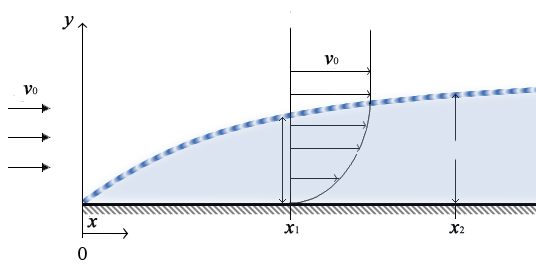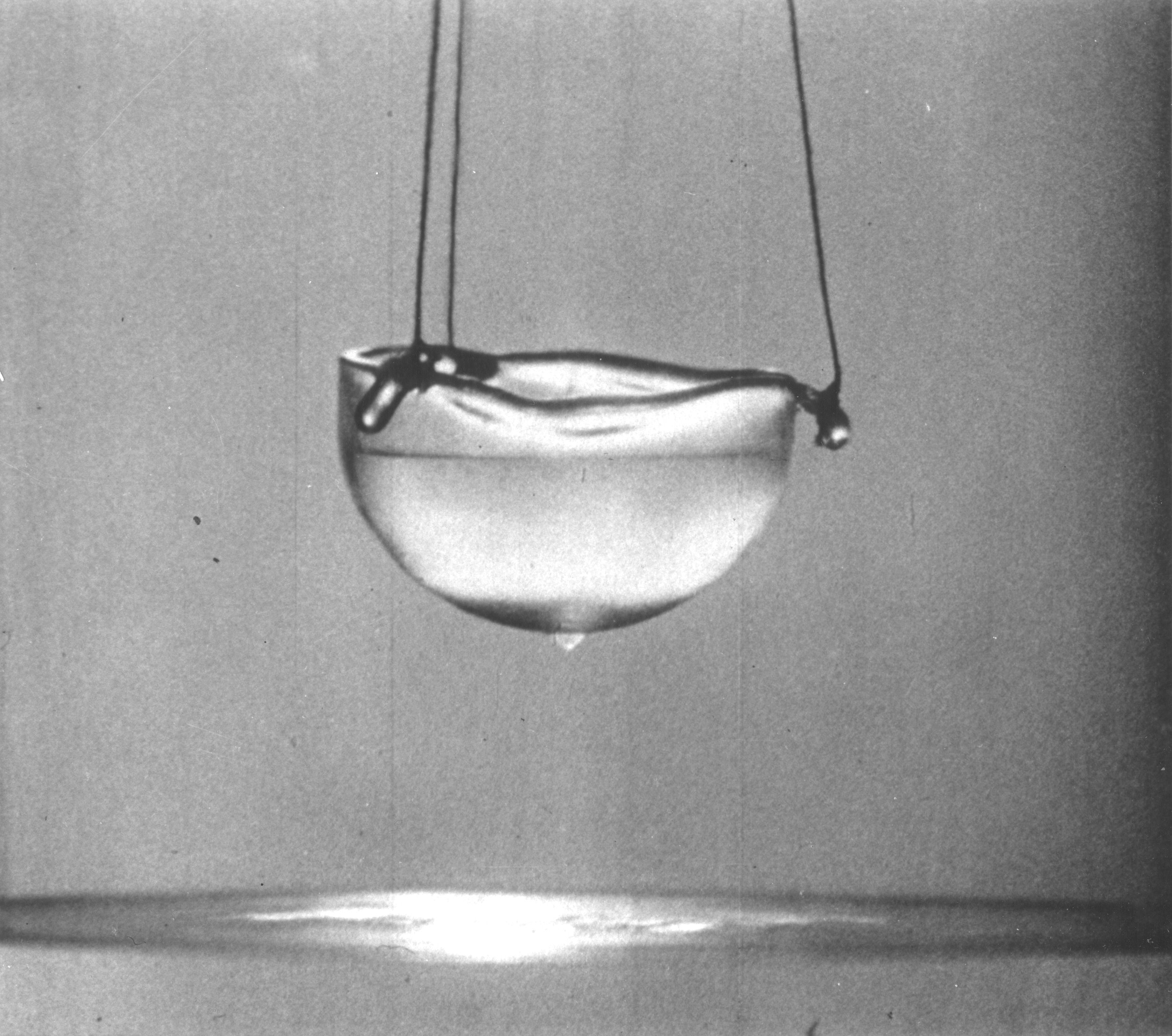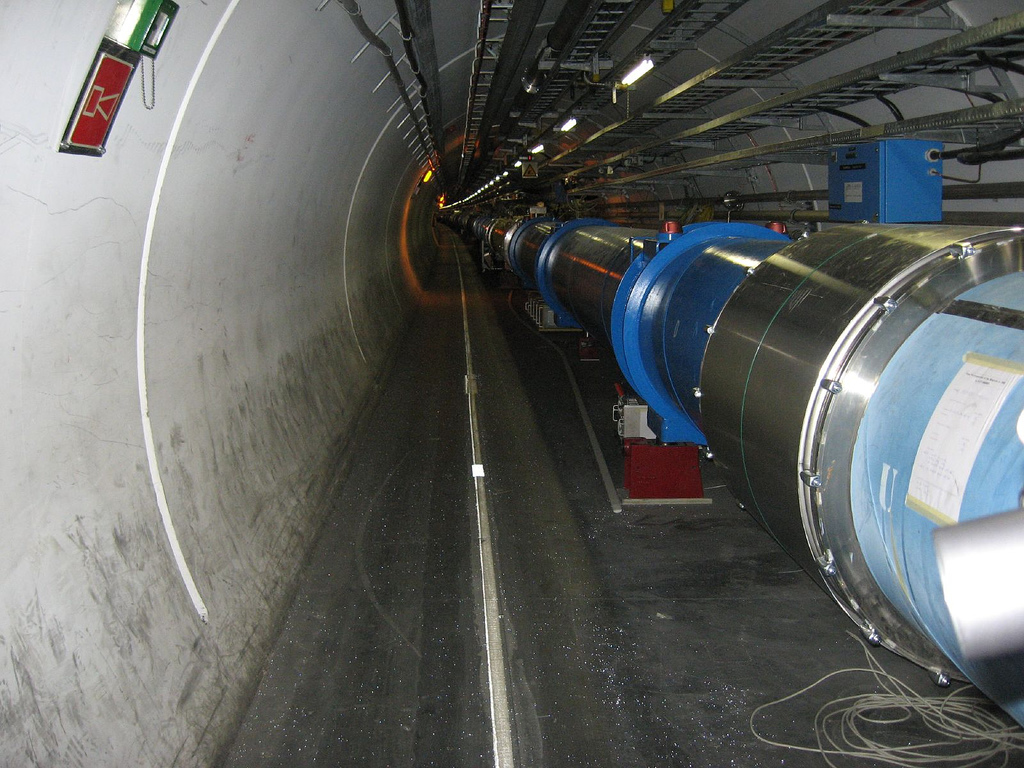Inviscid flow on:
[Wikipedia]
[Google]
[Amazon]
In fluid dynamics, inviscid flow is the flow of an inviscid (zero-
 In a 1757 publication,
In a 1757 publication,

 Superfluid is the state of matter that exhibits frictionless flow, zero viscosity, also known as inviscid flow.
To date, helium is the only fluid to exhibit superfluidity that has been discovered. Helium-4 becomes a superfluid once it is cooled to below 2.2K, a point known as the lambda point. At temperatures above the lambda point, helium exists as a liquid exhibiting normal fluid dynamic behavior. Once it is cooled to below 2.2K it begins to exhibit quantum behavior. For example, at the lambda point there is a sharp increase in heat capacity, as it is continued to be cooled, the heat capacity begins to decrease with temperature. In addition, the
Superfluid is the state of matter that exhibits frictionless flow, zero viscosity, also known as inviscid flow.
To date, helium is the only fluid to exhibit superfluidity that has been discovered. Helium-4 becomes a superfluid once it is cooled to below 2.2K, a point known as the lambda point. At temperatures above the lambda point, helium exists as a liquid exhibiting normal fluid dynamic behavior. Once it is cooled to below 2.2K it begins to exhibit quantum behavior. For example, at the lambda point there is a sharp increase in heat capacity, as it is continued to be cooled, the heat capacity begins to decrease with temperature. In addition, the
 Superfluid helium has a very high thermal conductivity, which makes it very useful for cooling superconductors. Superconductors such as the ones used at the LHC (Large Hadron Collider) are cooled to temperatures of approximately 1.9 Kelvin. This temperature allows the niobium-titanium magnets to reach a superconductor state. Without the use of the superfluid helium, this temperature would not be possible. Using helium to cool to these temperatures is very expensive and cooling systems that use alternative fluids are more numerous.{{Cite web, url=https://home.cern/about/engineering/cryogenics-low-temperatures-high-performance, title=Cryogenics: Low temperatures, high performance {{! CERN, website=home.cern, language=en, access-date=2017-02-14
Another application of the superfluid helium is its uses in understanding quantum mechanics. Using lasers to look at small droplets allows scientists to view behaviors that may not normally be viewable. This is due to all the helium in each droplet being at the same quantum state. This application does not have any practical uses by itself, but it helps us better understand quantum mechanics which has its own applications.
Superfluid helium has a very high thermal conductivity, which makes it very useful for cooling superconductors. Superconductors such as the ones used at the LHC (Large Hadron Collider) are cooled to temperatures of approximately 1.9 Kelvin. This temperature allows the niobium-titanium magnets to reach a superconductor state. Without the use of the superfluid helium, this temperature would not be possible. Using helium to cool to these temperatures is very expensive and cooling systems that use alternative fluids are more numerous.{{Cite web, url=https://home.cern/about/engineering/cryogenics-low-temperatures-high-performance, title=Cryogenics: Low temperatures, high performance {{! CERN, website=home.cern, language=en, access-date=2017-02-14
Another application of the superfluid helium is its uses in understanding quantum mechanics. Using lasers to look at small droplets allows scientists to view behaviors that may not normally be viewable. This is due to all the helium in each droplet being at the same quantum state. This application does not have any practical uses by itself, but it helps us better understand quantum mechanics which has its own applications.
viscosity
The viscosity of a fluid is a measure of its resistance to deformation at a given rate. For liquids, it corresponds to the informal concept of "thickness": for example, syrup has a higher viscosity than water.
Viscosity quantifies the int ...
) fluid, also known as a superfluid. The Reynolds number of inviscid flow approaches infinity as the viscosity approaches zero. When viscous forces are neglected, such as the case of inviscid flow, the Navier–Stokes equation can be simplified to a form known as the Euler equation. This simplified equation is applicable to inviscid flow as well as flow with low viscosity and a Reynolds number much greater than one. Using the Euler equation, many fluid dynamics problems involving low viscosity are easily solved, however, the assumed negligible viscosity is no longer valid in the region of fluid near a solid boundary (the boundary layer) or, more generally in regions with large velocity gradients which are evidently accompanied by viscous forces.
Inviscid flows are broadly classified into potential flows (or, irrotational flows) and rotational inviscid flows.
Prandtl hypothesis
Ludwig Prandtl developed the modern concept of the boundary layer. His hypothesis establishes that for fluids of low viscosity, shear forces due to viscosity are evident only in thin regions at the boundary of the fluid, adjacent to solid surfaces. Outside these regions, and in regions of favorable pressure gradient, viscous shear forces are absent so the fluid flow field can be assumed to be the same as the flow of an inviscid fluid. By employing the Prandtl hypothesis it is possible to estimate the flow of a real fluid in regions of favorable pressure gradient by assuming inviscid flow and investigating the irrotational flow pattern around the solid body.Streeter, Victor L. (1966) ''Fluid Mechanics'', sections 5.6 and 7.1, 4th edition, McGraw-Hill Book Co., Library of Congress Catalog Card Number 66-15605 Real fluids experience separation of the boundary layer and resulting turbulent wakes but these phenomena cannot be modelled using inviscid flow. Separation of the boundary layer usually occurs where the pressure gradient reverses from favorable to adverse so it is inaccurate to use inviscid flow to estimate the flow of a real fluid in regions of unfavorable pressure gradient.Reynolds number
The Reynolds number (Re) is a dimensionless quantity that is commonly used in fluid dynamics and engineering. Originally described by George Gabriel Stokes in 1850, it became popularized by Osborne Reynolds after whom the concept was named by Arnold Sommerfeld in 1908. The Reynolds number is calculated as: The value represents the ratio of inertial forces to viscous forces in a fluid, and is useful in determining the relative importance of viscosity. In inviscid flow, since the viscous forces are zero, the Reynolds number approaches infinity. When viscous forces are negligible, the Reynolds number is much greater than one. In such cases (Re>>1), assuming inviscid flow can be useful in simplifying many fluid dynamics problems.Euler equations
 In a 1757 publication,
In a 1757 publication, Leonhard Euler
Leonhard Euler ( , ; 15 April 170718 September 1783) was a Swiss mathematician, physicist, astronomer, geographer, logician and engineer who founded the studies of graph theory and topology and made pioneering and influential discoveries ...
described a set of equations governing inviscid flow:
Assuming inviscid flow allows the Euler equation to be applied to flows in which viscous forces are insignificant. Some examples include flow around an airplane wing, upstream flow around bridge supports in a river, and ocean currents.
Navier-Stokes equations
In 1845, George Gabriel Stokes published another important set of equations, today known as the Navier-Stokes equations. Claude-Louis Navier developed the equations first using molecular theory, which was further confirmed by Stokes using continuum theory. The Navier-Stokes equations describe the motion of fluids: When the fluid is inviscid, or the viscosity can be assumed to be negligible, the Navier-Stokes equation simplifies to the Euler equation: This simplification is much easier to solve, and can apply to many types of flow in which viscosity is negligible. Some examples include flow around an airplane wing, upstream flow around bridge supports in a river, and ocean currents. The Navier-Stokes equation reduces to the Euler equation when . Another condition that leads to the elimination of viscous force is , and this results in an "inviscid flow arrangement". Such flows are found to be vortex-like.
Solid boundaries
It is important to note, that negligible viscosity can no longer be assumed near solid boundaries, such as the case of the airplane wing. In turbulent flow regimes (Re >> 1), viscosity can typically be neglected, however this is only valid at distances far from solid interfaces. When considering flow in the vicinity of a solid surface, such as flow through a pipe or around a wing, it is convenient to categorize four distinct regions of flow near the surface: * Main turbulent stream: Furthest from the surface, viscosity can be neglected. * Inertial sub-layer: The start of the main turbulent stream, viscosity has only minor importance. * Buffer layer: The transformation between inertial and viscous layers. * Viscous sub-layer: Closest to the surface, here viscosity is important. Although these distinctions can be a useful tool in illustrating the significance of viscous forces near solid interfaces, it is important to note that these regions are fairly arbitrary. Assuming inviscid flow can be a useful tool in solving many fluid dynamics problems, however, this assumption requires careful consideration of the fluid sub layers when solid boundaries are involved.Superfluids
 Superfluid is the state of matter that exhibits frictionless flow, zero viscosity, also known as inviscid flow.
To date, helium is the only fluid to exhibit superfluidity that has been discovered. Helium-4 becomes a superfluid once it is cooled to below 2.2K, a point known as the lambda point. At temperatures above the lambda point, helium exists as a liquid exhibiting normal fluid dynamic behavior. Once it is cooled to below 2.2K it begins to exhibit quantum behavior. For example, at the lambda point there is a sharp increase in heat capacity, as it is continued to be cooled, the heat capacity begins to decrease with temperature. In addition, the
Superfluid is the state of matter that exhibits frictionless flow, zero viscosity, also known as inviscid flow.
To date, helium is the only fluid to exhibit superfluidity that has been discovered. Helium-4 becomes a superfluid once it is cooled to below 2.2K, a point known as the lambda point. At temperatures above the lambda point, helium exists as a liquid exhibiting normal fluid dynamic behavior. Once it is cooled to below 2.2K it begins to exhibit quantum behavior. For example, at the lambda point there is a sharp increase in heat capacity, as it is continued to be cooled, the heat capacity begins to decrease with temperature. In addition, the thermal conductivity
The thermal conductivity of a material is a measure of its ability to conduct heat. It is commonly denoted by k, \lambda, or \kappa.
Heat transfer occurs at a lower rate in materials of low thermal conductivity than in materials of high thermal ...
is very large, contributing to the excellent coolant properties of superfluid helium. Similarly, Helium-3 is found become a superfluid at 2.491mK.
Applications
Spectrometers are kept at a very low temperature using helium as the coolant. This allows for minimal background flux in far-infrared readings. Some of the designs for the spectrometers may be simple, but even the frame is at its warmest less than 20 Kelvin. These devices are not commonly used as it is very expensive to use superfluid helium over other coolants. Superfluid helium has a very high thermal conductivity, which makes it very useful for cooling superconductors. Superconductors such as the ones used at the LHC (Large Hadron Collider) are cooled to temperatures of approximately 1.9 Kelvin. This temperature allows the niobium-titanium magnets to reach a superconductor state. Without the use of the superfluid helium, this temperature would not be possible. Using helium to cool to these temperatures is very expensive and cooling systems that use alternative fluids are more numerous.{{Cite web, url=https://home.cern/about/engineering/cryogenics-low-temperatures-high-performance, title=Cryogenics: Low temperatures, high performance {{! CERN, website=home.cern, language=en, access-date=2017-02-14
Another application of the superfluid helium is its uses in understanding quantum mechanics. Using lasers to look at small droplets allows scientists to view behaviors that may not normally be viewable. This is due to all the helium in each droplet being at the same quantum state. This application does not have any practical uses by itself, but it helps us better understand quantum mechanics which has its own applications.
Superfluid helium has a very high thermal conductivity, which makes it very useful for cooling superconductors. Superconductors such as the ones used at the LHC (Large Hadron Collider) are cooled to temperatures of approximately 1.9 Kelvin. This temperature allows the niobium-titanium magnets to reach a superconductor state. Without the use of the superfluid helium, this temperature would not be possible. Using helium to cool to these temperatures is very expensive and cooling systems that use alternative fluids are more numerous.{{Cite web, url=https://home.cern/about/engineering/cryogenics-low-temperatures-high-performance, title=Cryogenics: Low temperatures, high performance {{! CERN, website=home.cern, language=en, access-date=2017-02-14
Another application of the superfluid helium is its uses in understanding quantum mechanics. Using lasers to look at small droplets allows scientists to view behaviors that may not normally be viewable. This is due to all the helium in each droplet being at the same quantum state. This application does not have any practical uses by itself, but it helps us better understand quantum mechanics which has its own applications.
See also
*Couette flow
In fluid dynamics, Couette flow is the flow of a viscous fluid in the space between two surfaces, one of which is moving tangentially relative to the other. The relative motion of the surfaces imposes a shear stress on the fluid and induces flow. ...
* Fluid dynamics
* Potential flow, a special case of inviscid flow
* Stokes flow, in which the viscous forces are much greater than inertial forces.
*Viscosity
The viscosity of a fluid is a measure of its resistance to deformation at a given rate. For liquids, it corresponds to the informal concept of "thickness": for example, syrup has a higher viscosity than water.
Viscosity quantifies the int ...
References